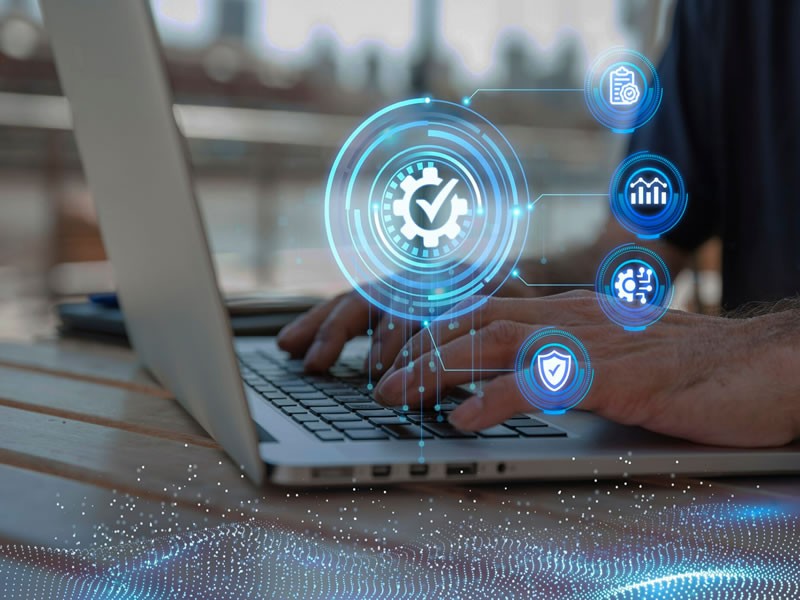Insight Blog
Agility’s perspectives on transforming the employee's experience throughout remote transformation using connected enterprise tools.
8 minutes reading time
(1504 words)
Steps to Successful Software Modernization - 2023 Guide
This article delves into the essence of application and software modernization. It explores the opportunities and risks associated with this process and subsequently outlines actionable approaches and best practices to guide organizations through this transformative journey.
Embracing digital transformation demands a proactive stance, with a crucial aspect being the modernization of software and applications. Successful digital transformation hinges on shedding legacy software applications and technologies that constrain an organization's capacity to foster a digital-first user experience and streamline business operations.
This sentiment resonates throughout the enterprise IT industry, as evidenced by a research survey encompassing 800 senior IT decision-makers in global enterprises. A staggering 80% of respondents express the belief that the failure to modernize applications and IT infrastructure will detrimentally impact their business's long-term growth.
Organizations that navigate the transition from legacy to modernized infrastructure technologies can anticipate a notable 14% annual increase in revenue. Moreover, they position themselves advantageously to seize opportunities in the upcoming phase of technological evolution.
This sentiment resonates throughout the enterprise IT industry, as evidenced by a research survey encompassing 800 senior IT decision-makers in global enterprises. A staggering 80% of respondents express the belief that the failure to modernize applications and IT infrastructure will detrimentally impact their business's long-term growth.
Organizations that navigate the transition from legacy to modernized infrastructure technologies can anticipate a notable 14% annual increase in revenue. Moreover, they position themselves advantageously to seize opportunities in the upcoming phase of technological evolution.
Frontier technologies, including artificial intelligence, blockchain, gene editing, and nanotechnologies, are expected to reach a market size of $3.2 trillion by 2025, according to a recent report by the United Nations Conference on Trade and Development (UNCTAD) (UNCTAD, 2023).
This article delves into the essence of application and software modernization. It explores the opportunities and risks associated with this process and subsequently outlines actionable approaches and best practices to guide organizations through this transformative journey.
What Is Software Modernization?
Application and software modernization refer to the process of updating and enhancing existing software and applications to meet current technological and business requirements. Software modernization company isn't just a facelift, as technology evolves rapidly, older software may become outdated, leading to issues such as security vulnerabilities, performance bottlenecks, and compatibility issues.
Modernization aims to address these challenges by adopting contemporary technologies, improving user experiences, and ensuring the long-term viability of the software.
This transformation involves various strategies, including the migration of legacy systems to cloud-based platforms, the adoption of microservices architecture for improved scalability and flexibility, and the use of modern development frameworks and methodologies.
It's not just about keeping up with the latest trends but also about optimizing efficiency, reducing costs, and staying competitive in a dynamic digital landscape. Application and software modernization empower organizations to harness the full potential of emerging technologies, enhance agility, and deliver enhanced value to end-users.
Three routes to software modernization encompasses various activities including
Application and software modernization involves updating existing software to leverage newer technologies, architectures, and platforms. This encompasses various activities, including:
- Rearchitecting: Implementing significant changes to the internal architecture of an application, such as transitioning from a monolithic to a microservices architecture.
- Rewriting: Completely redeveloping an application using a new programming language or framework.
- Replatforming: Shifting an application to a new cloud platform or infrastructure.
- Adding new features: Integrating fresh features and functionality into existing applications.
- Improving performance: Enhancing the speed and responsiveness of applications.
- Improving security: Strengthening applications against security vulnerabilities.
The objective of application and software modernization is to enhance the overall quality and efficiency of existing software while making it more adaptable to future changes.
How does modernizing software benefits organisation
Relying on outdated software to support business operations often results in heightened risks, escalated costs, and a significant reduction in business agility.
Now, let's explore the numerous advantages that come with opting to modernize your applications and software.
Modernizing software yields various benefits for organizations, supported by the following statistics:- Reduced costs: Modernized software is often more efficient and scalable, leading to significant cost savings. Organizations can save up to 30% on infrastructure costs, 20% on maintenance costs, and 25% on support costs by modernizing their software.
- Improved agility: Modernized software is easier to update and maintain, providing organizations with greater agility. Companies that embrace software modernization experience a 40% reduction in time-to-market for new features and functionalities.
- Enhanced security: Modernized software, built on more secure technologies, reduces the risk of security breaches. Organizations witness a 60% decrease in the likelihood of security incidents and data loss by modernizing their software.
- Better user experiences: Modernized software enhances user experiences by offering more features, functionalities, and performance. Organizations utilizing modern technologies report a 35% increase in user satisfaction and engagement.
- Increased innovation: Modernized software facilitates quicker and easier innovation. Organizations that prioritize software modernization are 50% more likely to introduce new products and services, fostering a culture of continuous improvement.
Follow us and access great exclusive content everyday: Follow us on Google News
Risks of modernizing
The prospect of legacy modernization may appear straightforward and practical when dealing with systems that have weathered multiple decades. The notion is clear: modernize for enhanced productivity. However, as the saying goes, "If it ain't broke, don't fix it." According to Gartner Research, steering away from legacy systems, such as the IBM mainframe, might incur higher costs and jeopardize quality.
Before embarking on a modernization endeavor that touches every facet of a company's processes, exercising caution is paramount.
Before embarking on a modernization endeavor that touches every facet of a company's processes, exercising caution is paramount.
Gartner recommends organizations contemplating a modernization project to take the following steps:
- Focus on Business Needs and Capabilities: Shift the focus from perceptions associated with terms like "fragile," "legacy," or even the preferred term "traditional" by Gartner. These terms can introduce biases that may lead decision-makers toward modernization when it may not be necessary or beneficial.
- Audit Existing Platforms and Processes: Examine current platforms and processes, emphasizing misalignments or gaps between business requirements and platform deliverables. Initiate the evaluation based on the existing landscape, avoiding assumptions that change is imperative.
- Consider Total Cost of Ownership: Evaluate the total cost of ownership, encompassing the cost of transitioning and dependencies over multiple years. Prioritize projects based on business needs and cost of ownership, ensuring that the chosen initiatives deliver maximum business value while minimizing associated risks.
Successful Software Modernization in 5 Steps
1. Evaluate Your Existing Systems
Initiate the modernization process by recognizing the mission-critical elements and functionalities within your IT system. Subsequently, identify any issues that may impede user experience, hinder application performance, or obstruct future growth.
During this assessment, it's crucial to also take maintenance costs into account. Your system should be user-friendly for support, and finding specialists familiar with your tech stack should not pose a significant challenge.
You may also like: Best Apps for Employees: UPDATED 2022 – A Complete Guide
2.Select the Right Modernization Approaches
Select the Appropriate Modernization Approaches for Your Requirements The widely adopted approaches to software modernization include:
- Encapsulation: Preserve and extend application features by encapsulating functions and data, offering them as services through an application programming interface (API).
- Rehosting: Redeploy application components to alternative physical, virtual, or cloud infrastructures without altering their code, functions, or features.
- Replatforming: Migrate an application to a new platform with minimal changes to the code, maintaining the existing code structure, features, and functions.
- Refactoring: Optimize and restructure existing code to improve nonfunctional attributes and eliminate technical debt, while keeping the code's external behavior unchanged.
- Rearchitecting: Significantly alter the code to introduce a different application architecture and leverage new capabilities.
- Rebuilding: Rewrite or redesign application components from the ground up while preserving their specifications and scope.
- Replacing: Completely eliminate and replace application components.
3. Develop a Roadmap for Modernization Strategy
When implementing new, extensive IT solutions into your business, a technology roadmap becomes indispensable.
This tool assists in delineating your overarching business goals, breaking them down into manageable milestones, assigning specific tasks to team members, identifying potential roadblocks, and more.
Free ebook: How To Get Your Intranet Off The Ground
4. Maintain Comprehensive Documentation
Thorough documentation is essential. Emphasizing the significance of a cohesive project documentation system cannot be overstated.
It guarantees alignment across the team, minimizes modernization costs, and fosters visibility, transparency, and accountability.
5. Begin with a Clear Direction
Whether you opt for a comprehensive implementation of your software modernization project or a gradual optimization of your tech stack, it's crucial to identify the specific areas of the system you intend to address first.
To achieve this, assess potential interdependencies and prioritize changes that offer the highest cost-to-reward ratio. Additionally, consider the benefits of making incremental modifications—a recommended approach. This method facilitates swift testing and iteration, shorter software release cycles, and a continuous improvement process.
Wrapping up
Modernizing legacy systems goes beyond mere technological updates; it's a strategic move to future-proof your organization. This process not only aligns with achieving business goals but also empowers companies to pivot towards emerging opportunities in the digital landscape.
The primary motivators for legacy modernization include enhancing customer experience, bolstering agility, and curbing costs. Key strategies for modernizing legacy systems involve cloud migration, application/software modernization, and data migration.So, if you want to keep your company's digital wardrobe fresh and in style, think about giving Sombra a shout. Here you have got the tools, the know-how, and the can-do attitude to take your software from outdated to outstanding.
Categories
Blog
(2618)
Business Management
(323)
Employee Engagement
(212)
Digital Transformation
(175)
Growth
(119)
Intranets
(115)
Remote Work
(61)
Sales
(48)
Collaboration
(36)
Project management
(29)
Culture
(28)
Customer Experience
(26)
Knowledge Management
(21)
Leadership
(20)
Comparisons
(6)
News
(1)
Ready to learn more? 👍
One platform to optimize, manage and track all of your teams. Your new digital workplace is a click away. 🚀
Free for 14 days, no credit card required.









![What Is an Intranet for Business? [2026 Guide] What Is an Intranet for Business? [2026 Guide]](http://agilityportal.io/images/easyblog_articles/1496/b2ap3_thumbnail_What-Is-an-Intranet-for-Business.png)




